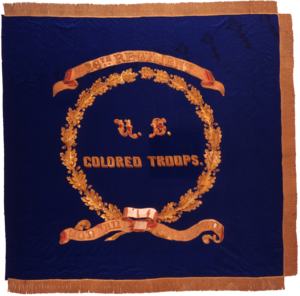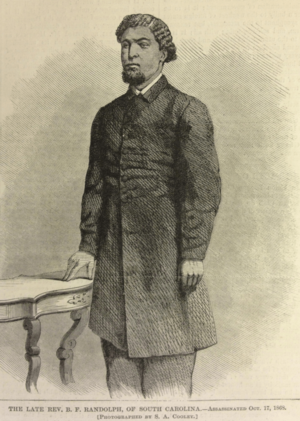Benjamin F. Randolph facts for kids
Quick facts for kids
Benjamin F. Randolph
|
|
|---|---|
| Member of the South Carolina Senate from the Orangeburg, SC district |
|
| In office August 11, 1868 – October 16, 1868 |
|
| Preceded by | Reconstruction Era |
| Personal details | |
| Born | 1820 Kentucky |
| Died | October 16, 1868 Hodges, South Carolina |
| Resting place | Randolph Cemetery 34°0′35.23″N 81°3′14.17″W / 34.0097861°N 81.0539361°W |
| Political party | Republican |
| Alma mater | Oberlin College |
| Profession | Minister (Christianity), Newspaper Editor, Educator |
| Signature | |
Benjamin Franklin Randolph (born 1820 – died October 16, 1868) was an important American leader. He was an educator, a minister, and a newspaper editor. During the Civil War, he served as a chaplain for the Union army. After the war, he became a politician and a state senator in South Carolina during the Reconstruction Era.
Randolph was one of the first African Americans chosen to be an Elector in the United States. This happened at the 1868 Republican National Convention for the Ulysses Grant presidential campaign. He also led the state's Republican Party. In 1868, he was a delegate at the South Carolina Constitutional Convention. Here, he helped create the first public education system for everyone in the state. He also helped give black men and poor white men the right to vote for the first time. Sadly, Benjamin Randolph was killed by members of the Ku Klux Klan on October 16, 1868.
Contents
Early Life and Education
Benjamin Franklin Randolph was born in Kentucky in 1820. His parents were free African Americans. When he was a child, his family moved to Ohio. He went to school in Warren County, Ohio.
In 1854, he started studying at Oberlin Preparatory & Collegiate. He then went to Oberlin College in 1857, where he studied classic subjects. In 1858, he moved to Buffalo, New York. There, he became the principal of a public school for black students.
Service During the Civil War
In December 1863, Randolph joined the Union army during the Civil War. He became a chaplain for the 26th Regiment Infantry U.S. Colored Troops in New York. He was the only African American officer in this regiment. On March 27, 1864, he received the Regimental banner at the unit's official ceremony.
His unit was sent to Beaufort, South Carolina, in March 1864. They fought in battles like the Battle of John's Island. They also fought at the Battle of Honey Hill and the Battle of Tulifinny. As a chaplain, Randolph helped soldiers by writing letters for them. He also helped care for the sick and wounded. The regiment finished its service in South Carolina in August 1865.
Reconstruction Efforts
After his army unit was disbanded, Randolph decided to stay in South Carolina. This was during the period known as Reconstruction. In 1865, he attended the Colored People's Convention in Charleston. After that, he joined the Freedmen's Bureau. He worked as an assistant superintendent for education in Charleston.
Randolph wanted to help his community. He wrote that he wanted a job where he could be most useful to his race. He felt his education and experience as a teacher would help. As an assistant superintendent, he started schools for formerly enslaved people on plantations around Charleston. He also found teachers for these new schools. Randolph traveled across the state to check on schools. He made sure they had enough staff and supplies.
In February 1867, Randolph helped start the Charleston Advocate. This was a weekly newspaper for formerly enslaved people. He was a co-editor of the paper. In March 1867, he became a minister in the Methodist Episcopal Church. He believed this church would help him serve the freedmen in South Carolina more effectively.
In late 1867, Randolph was chosen as a delegate for the South Carolina Constitutional Convention of 1868. At this important meeting, he wrote the part of the new state constitution that created the first free public education system. He also wrote the language that gave the right to vote to men who did not own land, both black and white. Before 1868, many white men who didn't own land could not vote. He also added a rule for "equal protection," meaning everyone should be treated fairly by the law, no matter their race. This was similar to the Fourteenth Amendment to the United States Constitution.
After the Convention, Randolph ran for the State Senate in Orangeburg. He won and was elected for a four-year term. He was also chosen to lead the Republican Central Committee for the state. He was a delegate to the 1868 Republican National Convention. There, Ulysses S. Grant was nominated for President. Randolph also became one of the first African American Electors in the country.
His Death and Legacy
As a state senator and Republican leader, Randolph traveled a lot to campaign. In October 1868, he was on a train tour to support Republican candidates. On October 16, 1868, while changing trains in Hodges, South Carolina, Randolph was shot and killed by three white men. This happened in broad daylight, with many people watching. The attackers rode away, and no one was immediately arrested.
Later, state authorities investigated. A warrant was issued for D. Wyatt Aiken, a former Confederate Army colonel. Aiken had publicly threatened Randolph. Aiken was arrested but later released and never went to trial. Another man, Fletcher Hodges, was also arrested but released.
In 1870, Congress held hearings about the situation in South Carolina during Reconstruction. A man confessed to being involved in Randolph's killing. He said he belonged to a group that wanted to "kill out the leaders of the Republican Party." This group was identified as the Ku Klux Klan. The witness later disappeared from jail and was shot by a constable. No one was ever brought to trial for Randolph's murder.
The 1868 Constitution that Randolph helped create was later replaced in 1895. The new constitution greatly reduced voting and legal rights for African Americans. However, some of Randolph's important ideas remained. These included free public education and the right to vote for landless men. The "equal protection of the law" clause also stayed.
In 1871, Benjamin Randolph was re-buried in a cemetery in Columbia, South Carolina, named in his honor. Eight other African American lawmakers from the Reconstruction era were later buried at Randolph Cemetery. In 1995, the cemetery was recognized as a historic place.
In 2008, the South Carolina General Assembly honored Randolph. They declared February 2, 2008, as "Senator Benjamin Franklin Randolph Day." This was to celebrate the 140th anniversary of the 1868 Constitutional Convention. A historic marker was also put up at Randolph Cemetery in his honor.
Images for kids



